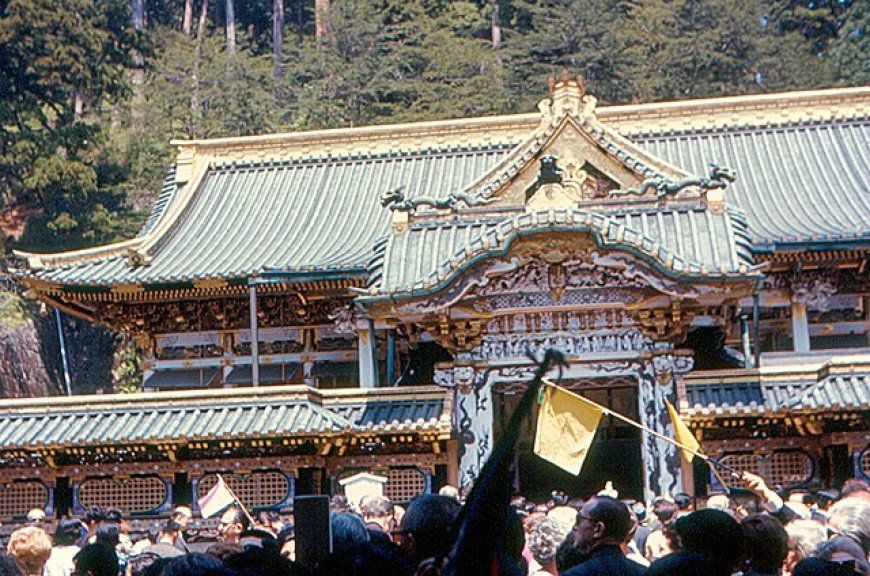10 famous sacred temples in Japan
Japan possesses many ancient Buddhist architectural works, which are hundreds or thousands of years old. Therefore, those temples have witnessed many ups and downs, the rise and fall of the country throughout its history.

MEIJI TEMPLE (MII TRI TEMPLE) – TOKYO
Unlike other shrines dedicated to the gods in Japan, Meiji Shrine, dedicated to Emperor Meiji Tenno and Empress Dowager Shoken Kotaigo, was built in 1920 in Tokyo's Shibuya district.
Kiyomasa no ido is a well known dug well located inside the shrine. The water temperature remains at 15 degrees Celsius year-round and the well provides 60 liters of water per minute. It is these special things that many people believe that the water here brings positive energy, attracting quite a few tourists queuing to admire and pray every day.
On New Year's Day, thousands of people come here to pray for luck, happiness, health and peace for themselves and their families. According to records, Meiji Jingu is also the most visited shrine in Japan on this occasion. A special feature is that traditional-style weddings will also be held at Meiji Jingu Shrine.
REPAIR SENSOJI (ASAKUSA KANNON) – TOKYO
Senso-ji Temple or Asakusa Kannon is Tokyo's oldest temple built in 645 (7th century), located in Asakusa, Taito-ku, Tokyo. Senso-ji has a very unique architecture, with ancient beauty, despite its history of more than a thousand years, the temple is still majestic and splendid.
Before entering the temple, you will have to pass through the Kaminarimon (Thunder Gate), the signature symbol of Asakusa and the city of Tokyo. This is one of the two main gates of the temple, built in 942. At the Kaminarimon gate at the entrance to Senso-ji Temple, there is a large lantern hanging in the middle of the gate, this lantern is famous around the world.
The main worshiping statue in the temple is the statue of Quan The Am Bodhisattva. This statue is also known as Asakusa Kannon. This is the place where the development of Edo culture was concentrated, and even now it still retains the ancient atmosphere of the Edo period.
Senso-ji Temple is also a place that attracts Japanese people to pray on New Year's Eve and on New Year's Day.
KINKAKU-JI REPAIR (Golden Guard Repair) – KYOTO
Kinkaku-ji Temple, built in 1397, is located in northern Kyoto. Through many events, the Kinkaku-ji temple that we now see as the temple has undergone many restorations.
The pagoda has 3 floors, except for the ground floor, and the two upper floors of the temple are inlaid with a thin layer of precious and sparkling gold, making the temple always bright, whether it is day or night. On the top of the roof is the image of a phoenix bird cast in bright and luxurious pure gold.
Behind the temple there is a pond, everyday the temple imprints its shadow on Kyoko-chi pond to create a feeling of tranquility and peace, and the people here call this pond Mirror pond.
In 1994, the temple was recognized by UNESCO as a world cultural heritage, and the temple was included in textbooks for teaching throughout Japan.
KIYOMIZU-DERA REPAIR (CLEAR WATER REPAIR) – KYOTO
Kiyomizu-dera Temple (also known as Thanh Thuy Temple) is located in the ancient capital of Kyoto, built in the early Nara period (778 AD) and is one of the oldest temples in Japan. Experiencing many events and fires, the original architecture is no longer available and the present temple was rebuilt in 1633.
Inside the temple grounds, there are 3 quite sacred waterfalls. It is believed that all three waterfalls correspond to the three desires of people: "longevity", "love" and "successful study". If you drink water in one of these three streams, good luck will come.
Inside the main hall of the temple, there is a statue of the 11-faced Guanyin Buddha with a thousand hands (thousand eyes) which is the national treasure of Japan. The pagoda was recognized by UNESCO as a world cultural heritage in 1994.
Kiyomizu-dera is a temple with a beautiful landscape in Japan. If you want to travel to Thanh Thuy pagoda, you can come in the period from March to May, or from October to November to see the perfect scenery of the temple when the cherry blossom season or the red leaf season. .
DAIGOJI REPAIR – KYOTO
Daigoji Temple is located in Fushimi-ku, one of the 11 wards of the ancient capital of Kyoto. This is a temple with a long history of development, ancient and peaceful beauty, and has been recognized by UNESCO as a "World Cultural Heritage".
Daigoji is surrounded by a forest of more than 300 hectares with a variety of large and perennial trees. Therefore, in every season of the year, this place is always filled with beautiful natural scenery and this place is also the place where a festival honors the beauty of cherry blossoms - the beauty of Japanese culture.
TODAIJI REPAIR (DONG DAI TU) – NARA
Todaiji (Eastern Great Temple) is a complex of Buddhist temples, built in 743. It is one of the most famous and most historically valuable temples in Japan.
Todaiji Temple is one of the oldest wooden temples in the world and is home to a great bronze statue of Buddha. This is not only a destination that attracts many Japanese tourists but also a place where Buddhists come back on their Buddhist pilgrimage.
Todaiji is recognized by UNESCO as the "Historic Monument Complex of the Nara Period".
KOTOKU-IN REPAIR – KAMAKURA
Kotoku-in Temple was built in 1238 in Kamakura City, Kanagawa Prefecture. This place not only impresses the public
--------------------------
Injavi.com - Visit in Japan

























































































